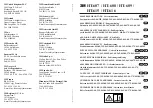
5. Wipe the interior of the air filter housing with a
shop rag dampened with cleaning solvent. Remove
any debris that may have passed through a broken
element.
6. Inspect the air filter element for tears or other
damage that would allow unfiltered air to pass into
the engine. Also check the element gasket (
Figure
4
) for tears. Replace the element if necessary.
7. Gently tap the air filter element to loosen the
dust.
CAUTION
In the next step, do not direct com
pressed air directly toward the inside
surface of the element. This will force
the dirt and dust into the pores of the
element, thus restricting air flow.
8. Apply compressed air toward the
outside sur
face
of the element (
Figure 5
) to remove all loos-
ened dirt and dust from the element.
9. Installation is the reverse of removal. Note the
following:
a. Install the air filter so the notches on the filter
engage the posts (
Figure 3
) on the air filter
housing.
b. Torque the air filter cover bolts (A,
Figure 2
)
to 10 N•m (89 in.-lb.).
Compression Test
An engine compression test is one of the quickest
ways to check the condition of the rings, head gas-
ket, piston and cylinder. Record the compression
reading during each tune-up in the maintenance log
at the end of the manual. Compare the current read-
ing with those taken during earlier tune-ups. This
will help to identify any developing problems.
Use a screw-in type compression gauge with a
flexible adapter (
Figure 6
) when performing this
test. Check the rubber gasket on the end of the
adapter before each use. This gasket seals the cylin-
der to ensure accurate compression readings.
Before starting this test, confirm that the cylinder
head bolts are tightened to the specified torque
(Chapter Four), the valves are properly adjusted as
described in this chapter, and the battery is fully
charged to ensure proper cranking speed.
1. Warm the engine to normal operating tempera-
ture, and turn the engine off.
58
CHAPTER THREE
3
4
5
6
















































